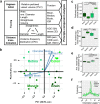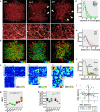Image-based modeling of vascular organization to evaluate anti-angiogenic therapy
- PMID: 36922848
- PMCID: PMC10018970
- DOI: 10.1186/s13062-023-00365-x
Image-based modeling of vascular organization to evaluate anti-angiogenic therapy
Abstract
In tumor therapy anti-angiogenic approaches have the potential to increase the efficacy of a wide variety of subsequently or co-administered agents, possibly by improving or normalizing the defective tumor vasculature. Successful implementation of the concept of vascular normalization under anti-angiogenic therapy, however, mandates a detailed understanding of key characteristics and a respective scoring metric that defines an improved vasculature and thus a successful attempt. Here, we show that beyond commonly used parameters such as vessel patency and maturation, anti-angiogenic approaches largely benefit if the complex vascular network with its vessel interconnections is both qualitatively and quantitatively assessed. To gain such deeper insight the organization of vascular networks, we introduce a multi-parametric evaluation of high-resolution angiographic images based on light-sheet fluorescence microscopy images of tumors. We first could pinpoint key correlations between vessel length, straightness and diameter to describe the regular, functional and organized structure observed under physiological conditions. We found that vascular networks from experimental tumors diverted from those in healthy organs, demonstrating the dysfunctionality of the tumor vasculature not only on the level of the individual vessel but also in terms of inadequate organization into larger structures. These parameters proofed effective in scoring the degree of disorganization in different tumor entities, and more importantly in grading a potential reversal under treatment with therapeutic agents. The presented vascular network analysis will support vascular normalization assessment and future optimization of anti-angiogenic therapy.
Keywords: 3D image analysis; Cancer; Light sheet fluorescence microscopy; Optical clearing; Tumor microenvironment; Vascular structure.
© 2023. The Author(s).
Conflict of interest statement
The authors declare no conflicts of interest. We further declare that the funders had no role in the design of the study; in the collection, analyses, or interpretation of data; in the writing of the manuscript; or in the decision to publish the results.
Figures





References
Publication types
MeSH terms
Substances
LinkOut - more resources
Full Text Sources
Medical

